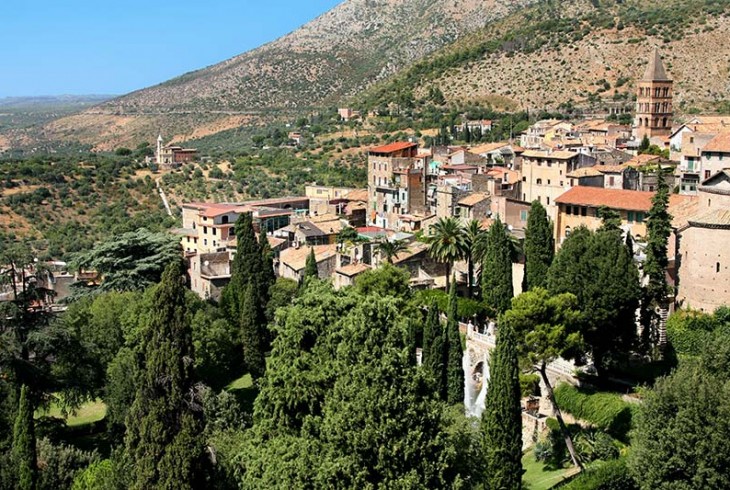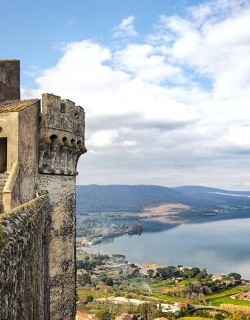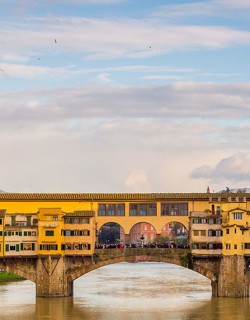If you’re looking to escape the bustling chaos of Rome for the day, then do as the ancient Romans did and head to the small town of Tivoli, spectacularly perched on the falls of the Aniene river high in the Sabine hills 20 miles to the east of the Eternal City. Boasting spectacular views over the Roman countryside, the real draw of Tivoli is its wonderful historical villas – the ancient Hadrian’s Villa, luxurious rural retreat of the eponymous Emperor, and the no less spectacular 16th-century Villa d’Este, whose expansive Renaissance gardens are amongst the world’s finest. Both are UNESCO world heritage sites for good reason, and at less than an hour from the capital visiting them together makes the perfect day trip from Rome. As if that wasn’t enough, Tivoli is also home to the Villa Gregoriana, a 19th-century masterpiece of picturesque design.
Read on to get the low-down on what you need to see at the 3 Tivoli villas:
- Hadrian’s Villa: The Wandering Emperor’s Countryside Retreat
- The Villa d’Este: A Renaissance Palace to Rival the Ancients
- Villa Gregoriana: A Mysterious Marriage of Art and Nature
1. Hadrian’s Villa: The Wandering Emperor’s Countryside Retreat
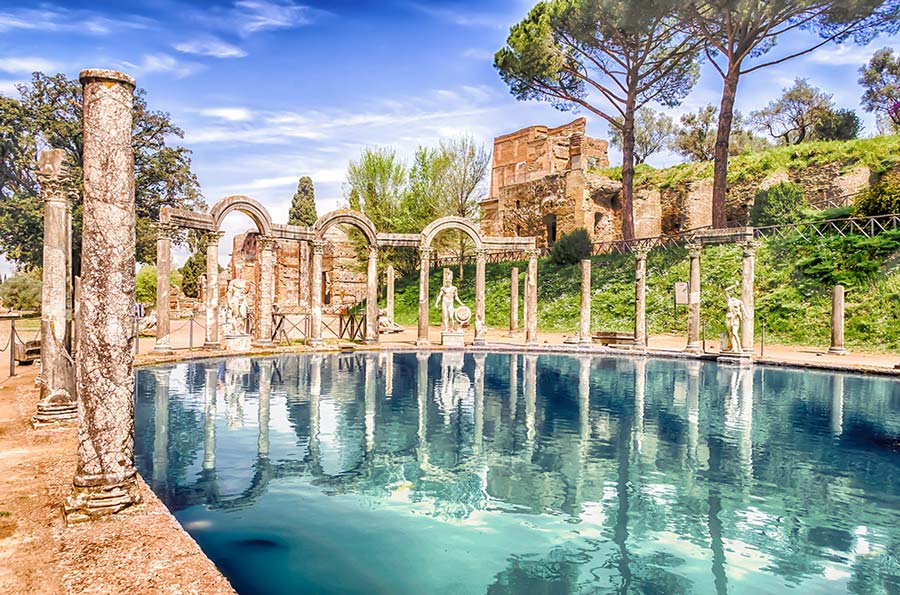
Nestled idyllically in the rolling Lazio countryside, Hadrian’s Villa is the largest and most spectacular villa of the entire ancient Roman world. Begun on the emperor’s command shortly after he ascended to power in 117 A.D. and continuously expanded over his 21 year reign, this immense archaeological site is more like a miniature city than a mere summer residence, covering an area larger than the footprint of Pompeii.
But just who was Hadrian? Born in modern day Spain, Hadrian was a cousin of the reigning emperor Trajan and rose to the top job after his death thanks to his marriage to Trajan’s great-niece. Traditionally known to history as one of the five good emperors (a fair claim, at least in comparison to acknowledged psychopaths like Nero and Caligula), Hadrian lacked his predecessors’ appetite for conquest - instead preferring to glorify the empire with immense architectural projects.
It’s to Hadrian’s building mania that we owe Rome’s incredible Pantheon, which still boasts the largest unsupported concrete dome ever built, and Castel Sant’Angelo – originally the emperor’s mausoleum. He was also responsible for the 73 mile long Hadrian’s Wall that kept Roman Britain safe from the marauding barbarians of the northern reaches, the largest Roman structure ever built. This was an emperor that didn’t do things by halves, and so it’s no surprise that his countryside retreat was built on a scale more fitting to god than man.
Like many of us Hadrian was afflicted with incurable wanderlust, and spent much of his reign on the road exploring the furthest-flung corners of his empire. The contemplative emperor never particularly liked the chaotic bustle of Rome, and wholly dissatisfied with his digs on the Palatine Hill he soon began constructing a rambling estate deep in the Roman campagna. In his later years the Tivoli villa became the official Imperial residence – from then on Rome would have to come to him, and it was from this pastoral idyll that he managed the affairs of the massive empire.
What To See at Hadrian’s Villa
As the empire’s de-facto centre of power, Hadrian’s Villa had a permanent population of thousands, including the Emperor’s private Praetorian guard – their barracks still survive, complete with communal latrines. An underground network of tunnels connected the villa’s various buildings, allowing a legion of slaves to ensure the smooth running of the estate without ever being seen by the elites above.
Above ground, the villa boasted everything the emperor needed in his quest to escape the intrigues of the Senate without sacrificing the trappings of power and privilege. You can visit the remains of libraries and theatres, bathhouses and banqueting halls, endless pavilions, pools and temples – including a mysterious tower known as the Roccabruna from where Hadrian observed the passage of the stars and which is spectacularly illuminated on the summer solstice.
The magnificent baths complex meanwhile boasted under-floor heating and a sauna to impress the Emperor’s guests. Its beautiful stucco decorations were shot off the walls by souvenir hunting English gentlemen on their Grand tours in the 18th century, but its coffered dome survives. No less impressive are the Latin and Greek libraries where you can admire beautifully preserved polychrome marble (opus sectile) floors.
But the absolute masterpiece of the Villa is the misleadingly named Maritime Theatre – in reality not a theatre at all but an extravagant artificial island surrounded by a canal ringed with a splendid colonnade. The island housed a miniature villa-within-a-villa, an inner sanctum accessible only by a retractable drawbridge reputedly designed by Hadrian himself, a keen amateur architect. Maybe a little too keen – Hadrian reputedly had the architect responsible for the Pantheon, Apollodorus of Damascus, executed for mocking one of his designs! When in less bloodthirsty mood the emperor retreated here to meditate and study in splendid isolation, surrounded only by his collections of exotic birds and fish.
Hadrian and Antinous: the Young Lover Made God
Hadrian’s decision to hole up in his vast countryside retreat wasn’t all about a quest for solitude – part of the villa’s appeal lay in the fact that it allowed him to spend quality time with his beautiful young paramour Antinous, who he had picked up on his travels through Turkey, far from the prying eyes of hostile senators and the stuffy rituals of downtown Rome.
Antinous drowned in mysterious circumstances in the river Nile at the age of 20 – a day later, the despairing emperor had him unofficially deified and temples sprang up in honour of the new god all over the empire. Hadrian built his tomb at the Tivoli villa, known as the Antinoeion, and studded it with enormous statues of the young Antinous dressed as the Egyptian god Osiris, one of which you can see in the Vatican Museums – Osiris rose from the dead in Egyptian mythology, and it seems that Hadrian hoped Antinous too would conquer death itself. The sepulchre’s centrepiece was a pink granite obelisk that you can now see in Rome’s Villa Borghese.
Greece and Egypt at Tivoli: Ancient Rome’s Greatest Theme-Park
Hadrian’s Villa doubled as an open-air museum where the emperor could show off the vast collections of art and antiquities that he had collected on his tireless travels. Obsessed with the cultures of ancient Greece and Egypt, the 4th century Historia Augusta recounts that Hadrian wanted various parts of the villa to recall or even materially reconstruct famous landmarks from the great ancient civilisations. You might even think of Hadrian’s Villa as an exotic ancient version of a theme-park, the emperor’s very own private Disneyland. Only instead of Fantasyland and Main Street, Hadrian designed fantasy versions of places like Athens’ Stoa Poikile - a spectacular painted porch where Greek philosophers debated the mysteries of the universe. In Hadrian’s re-imagining this became the pecile, a 429 metre long porch wrapping around a fish pond where the emperor and his guests took after-dinner strolls.
The most spectacular of these architectural flights of fancy is the Canopus – a fabulous 100-meter long canal flanked by curved colonnades, inspired by an ancient Egyptian waterway near Alexandria. Hadrian’s miniature reconstruction is lined with sculptures based on famous Greek works – caryatids copied from the Erechtheion on Athens’ Acropolis, and even a crocodile. At the far end of the canal rises the beautiful shell-shaped grotto that imitates a sanctuary dedicated to the Egyptian god Serapis. In these spectacular surroundings Hadrian and his guests sat down to lavish summertime banquets, the reflections of the illuminated statues dancing in the water. Even today this idyllic spot offers a breathtaking glimpse into the lavishness of antique taste - and the limitless luxury that absolute power could buy in the ancient empire.
2. The Villa d’Este: A Renaissance Palace to Rival the Ancients
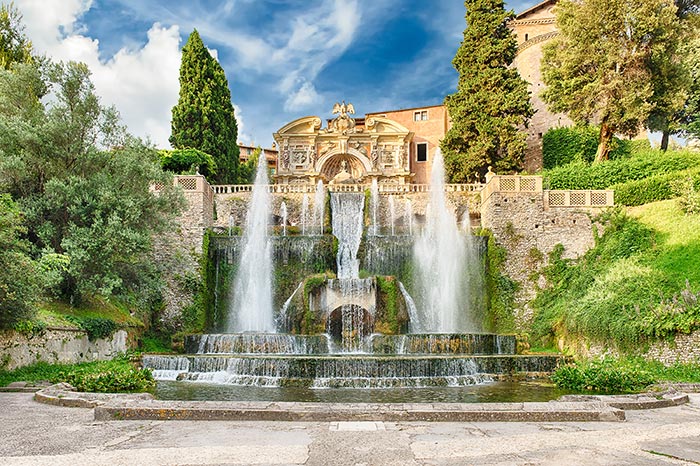
After the fall of the Roman Empire, Hadrian’s villa was abandoned and fell into oblivion. Its remains were finally identified in 1461, and Renaissance artists rushed in to draw and study the incredible find - Bramante and Raphael amongst them. When the multi-talented painter and architect Pirro Ligorio fully excavated the site a century later, the powerful d’Este family were watching on from their residence in the town above with mounting interest.
The clan’s pater familias, Cardinal Ippolito d’Este II, had nursed ambitions of becoming pope for his entire career. But after his hopes were dashed on account of his excessively lavish lifestyle (it seems he took after his mother, the notorious Lucrezia Borgia), he decided to channel his energies into building a villa in Tivoli that would be the envy of Rome’s high society. Taking the nearby Hadrian’s Villa as his inspiration, d’Este hired Ligorio himself to design a modern equivalent of the emperor’s palatial country pile. The stately villa d’Este was completed in the 1570s, and today stands as one of the most impressive and refined aristocratic Renaissance residences in all of Italy.
What to See at Tivoli’s Villa d’Este
The palace itself is impressive enough as it unfolds around courtyards and echoing halls decorated with colourful frescoes by the hands of the era’s most famous artists, including Livio Agresti and Federico Zuccari. But it’s Ligorio’s awe-inspiring terraced gardens built into the side of a cliff that will really take your breath away, and that ensured the Villa’s lasting fame. This was the spectacular stage for lavish outdoor parties thrown by Ippolito for the elites of Europe, bacchanals that matched anything Hadrian and his luxury-loving guests ever managed in the distant past of the valley below.
Boasting panoramic views of the Roman campagna from its 200-metre long terrace, the grounds of the Villa d’Este were one of Italy’s first giardini delle meraviglia - a garden of marvels. And a marvel it certainly is: you could easily spend an afternoon here getting lost amongst its winding paths shaded by the branches of soaring Roman cypresses. In rocky niches and sculpted caves, statues of ancient deities gaze outwards covered in moss and weathered by the passage of time. Given that it was built by a cardinal hoping to become pope, you might be surprised by the sensuous pagan gods lurking around every corner – a naked Venus caught emerging from her bath is located in a niche that was known in the 16th century as the ‘grotto of voluptuous pleasure’!
Water, Water Everywhere: The Fountains of Villa d’Este
But it’s water that makes the Villa, and it’s everywhere: over 50 fully-fledged sculpted fountains and nymphaeums, as well as 450 more spouts and jets and 64 cascading waterfalls are all fed by nearly a kilometre of canals flowing across the terraces – the sound of water follows you everywhere you go. Ligorio was also a highly skilled engineer, and incredibly the entirety of the waterworks are powered by gravity alone. To keep the cardinal’s demanding guests occupied, Ligorio also designed many of the fountains to perform tricks and illusions.
The most famous is the Fountain of the Organ, whose intricate hydraulic design meant that it was capable of playing pieces of music through the power of the water flowing through its hidden pipes. When Pope Gregory XIII arrived in 1582 (a visit that nearly bankrupted d’Este), he demanded to examine the mechanism in detail as he was convinced it was a trick and someone was hidden behind the fountain playing the music. After a meticulous restoration, the organ once again serenades visitors with its watery tunes, and at the time of writing, you can hear it playing every two hours starting from 10.30 a.m. daily.
Another spectacular highlight of the gardens is the so-called Hundred Fountains, a two-level walkway where a row of jets in the shapes of lilies, grotesque masks, eagles and boats all spew water into a long trough in perfect unison. Look out too for the Fountain of Rometta, a symbolic representation of the city of Rome in miniature, complete with little buildings and a boat carrying an obelisk in the centre, signifying the Tiber Island.
The gardens of the Villa d’Este have lost none of their allure over the centuries, and have fascinated everyone from the Hungarian composer Franz Liszt, who wrote Les Jeux d’Eau in the shadows of the fountains, to the avant-garde filmmaker Kenneth Anger whose Eaux d’Artifice is set amongst the relentless cascades.
3. Villa Gregoriana: A Mysterious Marriage of Art and Nature
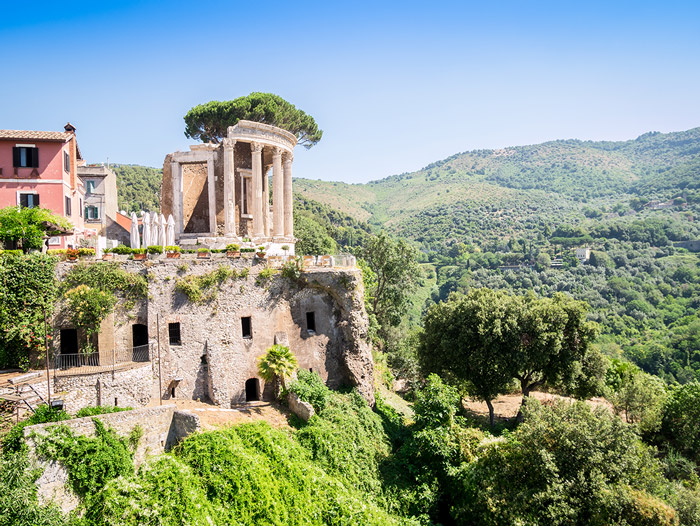
Tivoli boasts a third villa in its environs, less well-known than Hadrian’s Villa or the Villa d’Este, but well worth a visit in its own right. The Villa Gregoriana was the brainchild of Pope Gregory XVI in the 1830s, part of a project to contain the unruly river Aniene, and unlike the carefully designed spaces of its illustrious neighbours is a rustic haven for wildlife where untamed nature and Roman architectural remains vie for supremacy. Located in a valley known in antiquity as the Valle dell’Inferno, or the Valley of Hell, the villa is linked to the town by the picturesque Ponte Gregoriano. Pack your walking shoes, because this one’s quite a hike!
What to See at the Villa Gregoriana
Descending into the valley you’ll pass the spectacular 120 metre high Great Waterfall, where the rushing waters of the river Aniene spew out from the rock-face and tumble over a gorge – the same water that made the gardens of Hadrian and Ippolito d’Este possible, but that also threatened to engulf the town. At the base of the waterfall are dark and mysterious caves known as the Grotto of Neptune and the Grotto of the Sirens. Wreathed in the tangled trees and vines of the villa’s grounds you’ll also come across the remains of the ancient villa of the consul Manlius Vopiscus, immortalised by the poet Horace. Most impressive of all, though, is the incredible first-century B.C. Temple of Vesta, a circular temple ringed with beautifully carved Corinthian capitals perched on the edge of the abyss.
How to Get to Tivoli from Rome
There are three main ways to get to Tivoli from Rome. The easiest, and in our opinion best, option is to book a guided tour of Hadrian’s Villa and the Villa d’Este that includes private transportation from Rome - such as Through Eternity's Tivoli Day Trip from Rome.
If you want to go it alone and are just going to Hadrian’s Villa, then hop on the B line of Rome’s metro system heading north towards the terminus Rebibbia. Get off at the penultimate stop, Ponte Mammolo. The metro stop is linked to a bus station operated by the Cotral company – just follow the signs. Buy your tickets in the downstairs cafe at the station, asking for tickets to Tivoli. Get off at the Villa Adriana stop, 300 metres from the site. Just ask the driver to let you know the stop nearest the Villa and he or she will be happy to oblige. To plan your journey in advance, use Cotral’s online journey planner – enter Roma Ponte Mammolo in the “FROM” field and Villa Adriana in the “TO” field.
If you want to visit the Villa d’Este first, then you might find it easier to take the train from Rome’s Tiburtina station to the town of Tivoli. From here you can easily reach the Villa d’Este on foot. You can also catch a local shuttle bus that will take you to Hadrian’s Villa from here.
We hope you enjoyed our guide to the 3 Tivoli villas. If you’d like to learn more or want to arrange a trip to any of the sites featured in our guide, get in touch with Through Eternity today!
